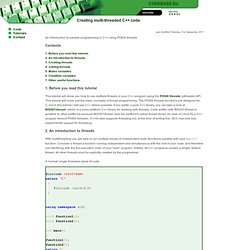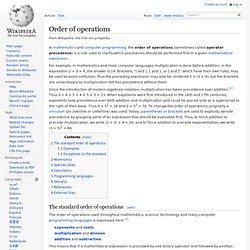

Javadoc Tutorial. C++ multithreading tutorial. Last modified Thursday, 01st September, 2011 An introduction to parallel programming in C++ using POSIX threads.

Contents 1. Before you read this tutorial. 2. An introduction to threads. 3. 1. This tutorial will show you how to use multiple threads in your C++ program using the POSIX threads (pthreads) API. 2. With multithreading you are able to run multiple blocks of independent code (functions) parallel with your main() function. A 'normal' single threaded piece of code : #include <iostream>extern "C" { #include <unistd.h> } using namespace std; void function1();void function2(); int main(){function1();function2();return 0;} void function1(){ cout << "hello...
" << endl ; sleep(2); } void function2(){ cout << " ....world" << endl ;} The code above is an example of a serial coded program. main() is executed and gives control to function1() - function1() gives control back to main() - main() gives control to function2() - function2() finally gives control back to main() again. Parameters : Computational complexity of mathematical operations. The following tables list the running time of various algorithms for common mathematical operations.

Here, complexity refers to the time complexity of performing computations on a multitape Turing machine.[1] See big O notation for an explanation of the notation used. Note: Due to the variety of multiplication algorithms, M(n) below stands in for the complexity of the chosen multiplication algorithm. Arithmetic functions[edit] Algebraic functions[edit] Special functions[edit] Many of the methods in this section are given in Borwein & Borwein.[5] Elementary functions[edit] The elementary functions are constructed by composing arithmetic operations, the exponential function (exp), the natural logarithm (log), trigonometric functions (sin, cos), and their inverses.
Below, the size n refers to the number of digits of precision at which the function is to be evaluated. Cplusplus.com - The C++ Resources Network. Order of operations. For example, in mathematics and most computer languages multiplication is done before addition; in the expression 2 + 3 × 4, the answer is 14.

Brackets, "( and ), { and }, or [ and ]", which have their own rules, may be used to avoid confusion, thus the preceding expression may also be rendered 2 + (3 × 4), but the brackets are unnecessary as multiplication still has precedence without them. The standard order of operations[edit] The order of operations used throughout mathematics, science, technology and many computer programming languages is expressed here:[2] exponents and roots addition and subtraction This means that if a mathematical expression is preceded by one binary operator and followed by another, the operator higher on the list should be applied first. It is helpful to treat division as multiplication by the reciprocal (multiplicative inverse) and subtraction as addition of the negation (additive inverse). Examples[edit] Exceptions to the standard[edit] Mnemonics[edit] . .